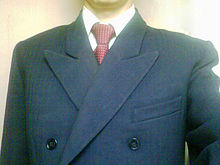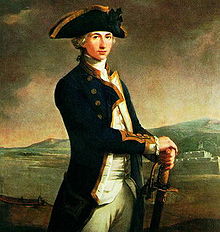- Jacket lapel
-
"Lapel" redirects here. For the town, see Lapel, Indiana.
Jacket lapels are the folded flaps of cloth on the front of a jacket or coat, and are most commonly found on formal clothing and suit jackets. Usually they are formed by folding over the front edges of the jacket or coat and sewing them to the collar, an extra piece of fabric around the back of the neck, as shown in the image.
There are three basic forms of lapels: notched, peaked and shawl. Notched lapels, the most common, are usually seen on business suits.[1] Peaked lapels are more formal, and nearly always used on double breasted jackets or coats.[2] Shawl lapels are usually carried by dinner jackets.[3]
Contents
Types of lapel
The notched lapel (American English), step lapel or step collar (British English) is sewn to the collar at an angle, creating a step effect. This is the standard on single breasted suits, and is used on nearly all suit jackets, blazers, and sports jackets. The size of the notch can vary, and a small notch is called fishmouth.[4]
The peaked lapel (American English), double breasted style lapel or pointed lapel (British English), is the most formal, featuring on double-breasted jackets,[2][5] and is now always worn with all formal coats such as a tailcoat[6] or morning coat, and also commonly with a dinner jacket (both single and double breasted). In the late 1920s and 1930s, the single breasted peaked lapel jacket was considered a very stylish design. The feature was carried into day clothing by the increasing popularity of the peaked dinner jacket.[7] This has gone in and out of vogue periodically, made popular once again during the 1970s by designers such as Armani, and is currently a trending style in the 2010s. The ability to properly cut peak lapels on a single-breasted suit is one of the most challenging tailoring tasks, even for very experienced tailors.[8]
The shawl lapel, roll collar, or shawl collar is a continuous curve. Originally seen on the Victorian smoking jacket, it is now most common on the dinner jacket (tuxedo).[3] This similarly began as informal eveningwear, and was then made in both more and less formal versions, depending on the situation in which it was to be used.
There are also other variations, such as the Nehru jacket, with no lapel.
Lapel features
Lapels have a buttonhole on the left, which is intended to hold a boutonnière, a decorative flower. These are now only commonly seen at more formal events. To hold the flower properly, a loop is fixed to the back of the lapel. For symmetry, double breasted suits often have a button hole on each lapel.[9]
A lapel pin is also sometimes worn, and in punk fashion, the lapels of leather jackets are often adorned with various buttons and pins, usually sporting typical punk images and popular punk band logos.[citation needed]
The width of the lapel is a widely varying aspect of suits, and has changed widely over the years. Some designers maintain however that most stylish lapel width does not change, and that the lapel "should extend to just a fraction less than the halfway mark between the collar and shoulder line."[10] The 1930s and 1970s featured an exceptionally wide lapel width, whereas during the late 1950s and most of the 1960s suits with very narrow lapels — often only about an inch wide — were in fashion. The 1980s saw mid-size lapels with a low gorge (the point where the jacket lapel and collar meet). In the 2000s, trends were towards a narrower lapel and higher gorge.[citation needed]
Origin
The usual style of lapel (the notched lapel) originated in older types of jacket or coat that buttoned to the neck, by unbuttoning and turning back the upper part of the closure at an angle indoors or in hot weather, and then removing the upper buttons. The upper points are derived from the end corners of the collar. This can be duplicated by similarly turning back the closure in a modern button-to-the-neck garment such as an outdoor coat or a boilersuit. Sometimes when caught outside in bad weather in a lapelled jacket and nothing over it, its wearer may unfold the lapels and hold them that way to temporarily reproduce the ancestral to-the-neck closure.
As tailcoats evolved rapidly among the wealthy during the Regency period, various styles of closure saw popularity, from fastenings at the top, the middle, or even hanging open. The turn-down collar popular on earlier garments like the frock was succeeded by long lapels folded down to below the waist (fashionably tightly nipped in). Invariably, there were long rows of buttons down the front, most of which did not fasten; in fact even into the late Victorian era, all frock coats had a long row of button holes on the lapel, long since obsolete. As buttoning styles changed, the loosely folded front of the coat correspondingly shifted shape, and the V then formed by the meeting of the fold and the collar continues now in the traditional shape of notched and peaked lapels, both of which originate from that period.
Once double breasted frock coats were established, lapels were sharply creased and their form was more static, varying only in details such as height, since they were buttoned nearly to the neck by the Edwardians, then lengthened to the classic three-button shape, the two-button jacket being a further American innovation. The other significant change over that period was the use of the revers in the construction of the lapel, as the Victorians used elaborate three-part patterns to cut a fold of cloth from the lining into the front of the lapel, a universal consideration of frock coats and dress coats of the period, but abandoned in favour of our current single-piece lapels at the same time as the switch to morning coats and lounge suits. Modern lapels are largely identical in form to their 1930s counterparts.
Some historians of dress such as Bernard Rudofsky have ridiculed the evolution of jacket lapels into "vastly unnecessary flaps" and "decorative rudiments," [11] while others have celebrated the transformation of lapels into "fetishes" as part and parcel of fashion as expression.[12]
Bibliography
- Antongiavanni, Nicholas (2006). The Suit: A Machiavellian Approach to Men's Style. HarperCollins. ISBN 978-0-06-089186-2.
- Flusser, Alan (1985). Clothes and the Man: The Principles of Fine Men's Dress. Villard. ISBN 0-394-54623-7. http://www.throughtherye.com/flusser/index_current.html. Retrieved 2008-09-20.
- Flusser, Alan (2002). Dressing the Man: Mastering the Art of Permanent Fashion. HarperCollins. ISBN 0-06-019144-9.
- Rudofsky, Bernard (1947). Are Clothes Modern?. Paul Theobald.
- Whife, A.A (ed): The Modern Tailor Outfitter and Clothier. The Caxton Publishing Company Ltd, London, 1951
Notes
- ^ Flusser (2002). p. 83
- ^ a b Flusser (2002). p. 85
- ^ a b Antongiavanni (2006). p. 172
- ^ Antongiavanni (2006). p. 48
- ^ The rare notched lapel double-breasted jacket was briefly seen in the mid 1980s and 1990s as part of some power suits.[citation needed]
- ^ Flusser (2002). p. 234
- ^ Flusser (2002). p. 84
- ^ Mahon, Thomas (2005-03-29). "Single breasted, peaked lapel". English Cut. http://www.englishcut.com/archives/000052.html. Retrieved 2008-09-20.
- ^ Boehlke, Will (2007-01-07). "What's in your lapel?". A Suitable Wardrobe. http://asuitablewardrobe.dynend.com/2007/01/whats-in-your-lapel.html. Retrieved 2008-09-24.
- ^ Flusser (1985). ch. 2
- ^ Rodofsky(1947). p. 122
- ^ Machete, A.J. (2010-10-28). "Jacket Lapels". The Complete Suit Guide. http://denverbespoke.com/?p=687. Retrieved 2011-10-27.
Categories:- Jackets
- Suits (clothing)
- Parts of clothing
Wikimedia Foundation. 2010.





